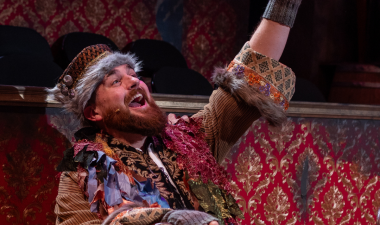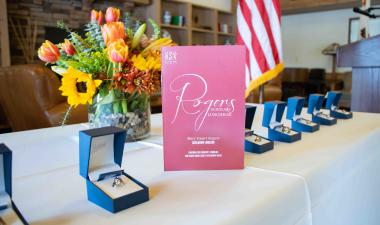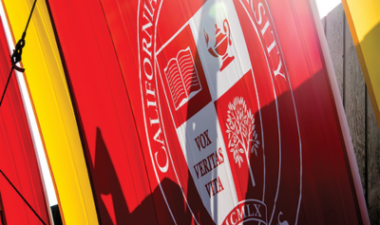Interesting new courses are being offered this semester in the College of the Arts, Humanities and Social Sciences.
Students in and out of the majors can explore new subjects in art, history, criminal justice’s legal concentration and theatre arts.
All were created as the college and individual disciplines seek to expand their offerings to better serve students.
ART 4549 Latin American Modernism (Satisfies G.E. UD-C.)
Stanislaus State’s Art Department is embracing the University’s role as a Hispanic Serving Institution and has created six courses about art in the Americas, specifically Latin America, Mexico, Central America, the Caribbean and South America.
This semester’s offering, Latin American Modernism, will be followed in the spring with Latin American Contemporary Art, the research specialty of Assistant Professor Alice Heeren, who is in her second year at Stan State.
A native of Brazil who traveled extensively and lived abroad with a mother who was a chemist, Heeren earned her Bachelor of Fine Art in Brazil, her master’s at the School of Art Institute of Chicago and Ph.D. at Southern Methodist University.
Heeren taught pre-Columbian art last fall, as well as an art history survey course of non-Western areas (Latin American, Asia and Africa). A course on colonial art, the era that follows pre-Columbian art on the timeline, will be available in the 2024-25 academic year. The department also added a Survey of Latin American Art course.
“We see Mexican muralism to concrete art and abstraction to participatory art, conceptual art,” Heeren said. “All of these periods are in many ways connected to the U.S. and Europe, but they look very different in Latin America. They’re very politicized and they have a lot of questions of race and ethnicity that are constant parts of those movements.”
Besides looking at the art in those different eras, Heeren teaches about the time in which they were created and the history that preceded them. All inform the artists.
“I get very interested students in the sense they recognize some of their family’s ancestry and some customs and aesthetics in the art,” Heeren said.
Some are familiar with specific art, or eras, whether by Frida Kahlo or the muralism of Diego Rivero or Siqueiros, or art of the independence era and Mexican Revolution, including photographs of Pancho Villa.
“I’ve had students who tell me they’ve done a genealogy test and found out they have genetics that connect to the Aztecs,” Heeren said. “They say, ‘My family is from Mexico, but I didn’t know it went back that far.’ They really are interested in the art of this region, some very early, pre-Columbian.”
Her courses cover a wider region, though, including the Caribbean, Central and South America.
Her students, she said, seem interested in learning how their own culture and history connect with others in the region.
HIST 4950 Introduction to Public History
In simplest terms, public history is “history outside of the classroom, what students can do with history if they don’t want to teach,” according to Assistant Professor Jennifer Cullison, who was hired to create a public history track.
The introductory class, offered in nine segments, features guest speakers from the myriad areas where those who love history can continue to engage in it, whether at museums, with monuments, parks, in historic preservation or creating documentaries.
“It’s to widen their perspective of what history can be, to excite the students who want to do something with history but don’t want to teach,” Cullison said. “Also, it can be for students who want to go into K-12 or academia and want to add a level of civic engagement to the kind of history they teach.”
Too often, students are turned off by history thinking it’s about memorizing dates and names. Cullison and her history department colleagues help students develop critical questions of the past and to develop their own answers through careful and responsible analysis of different types of historical evidence. Cullison works to prepare public history students to do collaborative community histories and to shape these analyses for diverse audiences.
Among the nine areas she covers over the semester of Introduction to Public History is oral histories, which is her area of expertise. While working toward her Ph.D. and then teaching at the University of Nevada, Reno, Cullison spent the pandemic creating an oral history project on immigrants, another area of her research and expertise. She will soon be teaching an oral history course at Stan State.
One of her ideas is to create a walking history of the campus, using clips of recorded oral histories in the J. Burton Vasché Library archives. Students will each pick a campus location to highlight, find a clip from the digitized oral histories to use, and tell the story of the site, saving it on a phone app that will be accessed with a QR code.
Cullison will demonstrate the process with the Trans-California Pathway. She is conducting an oral history with Donna Pierce, for whom the pathway is named, with her late husband, Wayne.
In time, the oral histories course will develop other projects. It’s special to Cullison, she said, because “one thing oral histories often do is bring a new perspective, usually from a population that doesn’t usually get included in the narrative.”
CJ 4750 Applied Legal Skills I
Judith Bandermann arrived at Stan State a year ago and is teaching another experiential course in criminal justice’s legal studies concentration.
Applied Legal Skills I joins Mock Trial and Court Observer, which Blake Wilson created in the last few years.
Bandermann’s course, designed for third-year students, has them taking on cases referred by the California Rural Assistance League (CRLA).
Students are learning to read a client’s legal record to determine if some of their old arrests or convictions might be cleared or reduced.
“The idea is you have this narrow area of legal practice, which is getting people’s records cleared, so that includes reducing felonies to misdemeanors, then also getting convictions expunged or dismissed,” said Bandermann, a licensed attorney. “It doesn’t erase them, but it makes them invisible on a background check for most purposes.
“The nice thing about it in terms of having an undergraduate clinic that runs semester to semester is it is a quite narrow area of law. The rules are quite complex, but not too complex that students can’t learn it. So, they learn the law, the laws that set out eligibility for getting your record cleared, and they also learn the procedures that are involved in filing the record-clearance petitions.”
Her 18 students are handling 22 clients, most in Southern California. They are spending the first half of the semester learning the laws and how to understand an individual’s legal record. Later, they will meet the clients via Zoom. Bandermann will review their work, as will a CRLA attorney, who will represent the clients in court.
Offering such a course at the undergraduate level is unique, but Bandermann has worked to make it available to Stan State students.
“We have real clients in the community that are helped,” she said. “The students learn legal eligibility. They have to learn court procedures. They’ve got to learn a lot of soft skills and professional skills in terms of ethics and communication and sensitivity.
“The class is educational on a number of fronts. Students see the role of psycho-social or developmental factors, family factors, the role of the system, how people get caught up in the system and how people crawl out of it. It’s infrequent in criminal justice curricula where you talk to people who have exited successfully.”
THEA 3800 Musical Theatre Audition Workshop
On the road to offering a Bachelor of Arts in Musical Theatre with a projected launch in fall 2024, Assistant Professor Jamie Johns is offering what will become a required class.
“There are certain skills musical theatre majors need to acquire over the course of their four years,” Johns said. “One of those skills that’s really important is a synthesizing skill, and it’s the ability to effectively audition, to prepare music quickly, to communicate effectively with an accompanist, to present yourself professionally and awareness of the importance of knowing what the rules of the room are. It’s a slightly mystifying process for people who aren’t a part of the industry. This class is about de-mystifying.”
As it is offered for the first time, Johns invited non-musical theatre students to enroll. While they have to do a bit of singing and dancing, and Marika Becz is co-teaching the class and handling the voice and movement segments, there are other skills being taught that will help any major.
“With college graduates, the careers they are going to be going out to, even if it’s just a job interview, even if that’s the only time you have to interact in such a way, the skills we are emphasizing, and the protocols and ideas we are introducing in this audition workshop, have ramifications and have the ability to be used in other ways,” Johns said.
He’s providing practice for any job interview: communication skills, presentation abilities and the kinds of approaches one needs to prepare.
“Preparation is paramount to auditioning,” Johns said. “We can talk for days with these students about what you do when you actually get in the room, but I tell all my students in theatre, the whole career is based on three components: preparation, opportunity and luck. The only ones you are responsible for are preparation and opportunity. Preparation is obvious. You can put as much time into getting ready for an interview, an audition, and that time should be effective. It should be used in a way that makes your interview more successful.”
For musical theatre students, the workshop will help them begin building a binder with two songs they might use for an audition with arrangements for a pianist to use. Initially, Johns hoped to create binders of five songs. He scaled it back when he included non-musical theatre students.
“I’m finding it more invigorating,” he said. “I feel we’re getting at the heart of the matter more thoroughly.”
And the takeaway for non-majors: “They think they don’t have to sing and dance to get a job, but metaphorically they do,” Johns said.



